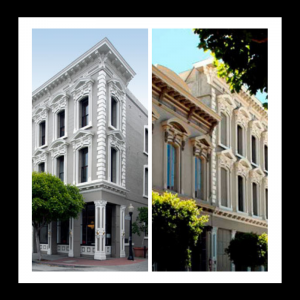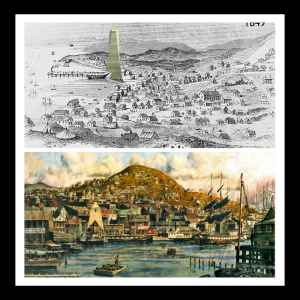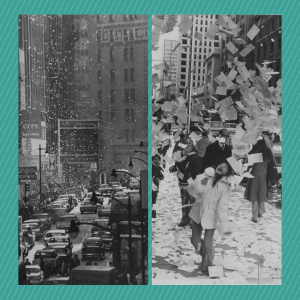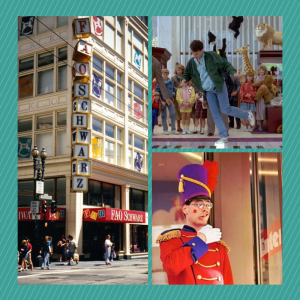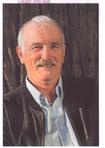John Michael McCarty's Blog, page 3
January 20, 2019
Hotaling
In 1866 you deboard a three-masted ship, step ashore onto Battery Street and cross over land-filled Yerba Buena Cove into Jackson Square. While navigating this section of San Francisco’s Barbary Coast, you keep a wary eye out for pickpockets, con artists, and false solicitors offering everything from snake oil to a free drink of pisco to the unfettered company of the fairer sex. You make your way past the Custom House to a large warehouse at 451 Jackson Street. Mr. Hotaling invites you to his second-story office where you negotiate the price of his whiskey for shipment back East.
Hotaling:
Decades later you learned the fate of Hotaling’s whiskey during the 1906 earthquake and fire. The Army had plans of dynamiting the brick structure to create a fire path until it realized the value of its contents. The largest repository on the West Coast of distilled spirits surely deserved to be saved. Seawater was pumped an incredible eleven blocks from the Embarcadero. Wine pumps from nearby basements added sewer sludge to the two-day victorious fight. However, much of San Francisco was not as fortunate, losing 28,000 buildings and historic mansions including Mr. Hotaling’s private residence in Pacific Heights. Many believed that the City had paid for its sinful ways. Local poet Charles Field responded with a bit of wit: “If, as they say, God spanked the town / For being over-frisky / Why did He burn His churches down / And spare Hotaling’s whiskey?”
These stately streets and alleys no longer harbor the hustle and chaos of yesteryear. Today, the historic brick structures house mainly art, antique and furniture dealers. The finer tastes and extravagances of modern day have replaced the sins of our ancestors…at least for Jackson Square. But not to worry, there is still plenty of Satan’s handiwork available in other neighborhoods of the City that knows how. Cheers!
The post Hotaling appeared first on John McCarty.
January 16, 2019
Old Ship Saloon
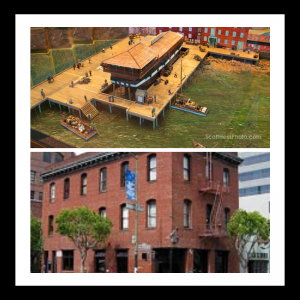 Over 500 ships were abandoned in San Francisco Bay as crew members fled for the gold fields in 1849. Many vessels, like The Arkansas, became part of the Yerba Buena shoreline awaiting their next life. The Arkansas was converted into The Old Ship Ale House near what is now Pacific Avenue and Battery Street, selling drinks at twenty-five cents each. By 1855, rotten timber and ballast stones from other crafts landlocked The Arkansas, causing it to become a permanent fixture of the Barbary Coast District.
Over 500 ships were abandoned in San Francisco Bay as crew members fled for the gold fields in 1849. Many vessels, like The Arkansas, became part of the Yerba Buena shoreline awaiting their next life. The Arkansas was converted into The Old Ship Ale House near what is now Pacific Avenue and Battery Street, selling drinks at twenty-five cents each. By 1855, rotten timber and ballast stones from other crafts landlocked The Arkansas, causing it to become a permanent fixture of the Barbary Coast District.
Supposedly the term “shanghaied” originated from this bar. A drug-laced liquor would render an unsuspecting patron unconscious.
Old Ship Saloon:
Paid interlopers would cart their victim to a shanty on the eastern slope of Telegraph Hill where he would be detained until the next outbound vessel. The Old Ship Saloon has been serving good, bad and indifferent spirits on this site ever since, making it the oldest watering hole in San Francisco. The bartenders at 298 Pacific Avenue have long retired the shenanigans of shanghaiing their clientele, so you’re free to have a drink without fear of waking up lost at sea. I can recommend the Gold Rush drink of choice…pisco, the first distilled drink along the West Coast. This brandy from Peru soon evolved into a punch mixed with pineapple, lime juice, sugar, gum Arabic and water. The drink’s powers caused one reviewer of the day to note: “It tastes like lemonade but comes back with the kick of a roped steer.” Cheers!
The post Old Ship Saloon appeared first on John McCarty.
January 12, 2019
Barbary Coast
The Barbary Coast of San Francisco gets its name from the Barbary Coast region of Northwest Africa, essentially where Morocco, Algeria, Tunisia and Libya are today. This region was known for its slave traders and pirates, with all the complementary unsavory types such as gamblers, pimps, thieves, etc. Its namesake in the City is nine-square-blocks bounded by Pacific Ave. on the north, Clay St. on the south, Montgomery St. on the east and Stockton St. on the west. This includes most of Chinatown, Jackson Square and parts of the North Beach District. The tens of thousands gold seekers in 1849 would overrun the town. The population increased from 400 to 25,000 within the year.
Barbary Coast:
A forest of masts occupied Yerba Buena Cove, which edged up to where the Transamerica Pyramid is today (upper photo). The Barbary Coast soon became victim to graft, lawlessness and every other vice known to man. The petty thief, the house burglar, the tramp, the whoremonger, lewd women, cutthroats, murderers were all found in the district’s dance-halls, concert-saloons, gambling houses and brothels. Debauchery, disease, insanity and death ran amuck.
A three-block stretch along Pacific was almost wall-to-wall with drinking establishments. “Deadfalls” were the lowest of these establishments with hard benches, sawdust floors and putrid wine , which was made from raw alcohol with added coloring. With only one policeman for every 1,500 souls, an average of one murder per night occurred. The number of brothels rivaled that of Paris. Ladies of the night were in high demand as men outnumbered women 70 to 1. Opium was sold openly in all-night drug stores. The city that knew how was an open-air den of iniquity.
The post Barbary Coast appeared first on John McCarty.
January 7, 2019
Gold Mountain Monastery
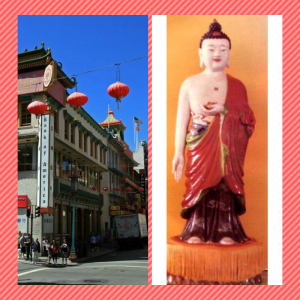 If you are seeking a genuine Chinese experience, ring the buzzer at 644 Broadway in San Francisco where a nun will welcome you. When the door closes behind you at the Gold Mountain Monastery, all outside interference suddenly dissolves as you enter another world. Incense laces the air as a strange sense of peace engulfs you.
If you are seeking a genuine Chinese experience, ring the buzzer at 644 Broadway in San Francisco where a nun will welcome you. When the door closes behind you at the Gold Mountain Monastery, all outside interference suddenly dissolves as you enter another world. Incense laces the air as a strange sense of peace engulfs you.
You are escorted into a chamber where devotees sit on mats while embracing the teachings of Buddha. Foreign words like sila, samadhi and prajna escape your understanding. But after a brief wait, you recognize familiar disciplines from bygone days such as “all beings are equal”, “a moral life”, and “the importance of education”. Twists on these universal truths tickle your curiosity as ideas of reincarnation, meditation and enlightenment are presented.
Gold Mountain Monastery:
A sudden realization coats your mind: that your beliefs are not so disconnected from this sixth century B.C. teacher known as Buddha. While Buddhism does not profess to worship a singular all-powerful Being, you begin to understand that what propels one to perform good deeds has been around for ions. You leave with a reaffirmation of what you already knew but have not seen practiced lately. To quarrel, to pursue greed and personal advantage, and to tarnish the truth have no place in your life. The racket of the street becomes mere “white noise” in the background as you walk with an unhurried gait. Note: All curiosity seekers are welcome at Gold Mountain Monastery any day of the week.
The post Gold Mountain Monastery appeared first on John McCarty.
January 5, 2019
Tin How Temple
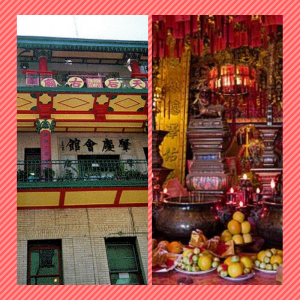 The Tin How Temple at 125 Waverly Place was born in the 1850’s amidst the chaos and excitement of the Gold Rush. Its body, the Barbary Coast District, encompasses parts of modern-day Chinatown, Jackson Square and North Beach. Tin How is the oldest operating Chinese temple in the U.S., which honors T’ien Hou, revered as the guardian angel of fishermen and women in distress.
The Tin How Temple at 125 Waverly Place was born in the 1850’s amidst the chaos and excitement of the Gold Rush. Its body, the Barbary Coast District, encompasses parts of modern-day Chinatown, Jackson Square and North Beach. Tin How is the oldest operating Chinese temple in the U.S., which honors T’ien Hou, revered as the guardian angel of fishermen and women in distress.
As you enter what feels like a secret passageway to some urban myth, authenticity abounds. You survey the walls of the stairwell lined with ancient sagas. These artworks and photos of history accompany you as you pass the second floor, labeled “Mahjong Parlors”. Another two flights brings you to a place of prayer. The quiet demands respect with only the sound of a devotee shaking a cup of kau cim sticks penetrating the stillness. The person exchanges the one stick that has fallen to the floor for a corresponding paper with an answer to his/her prayers.
Tin How Temple:
Massive gold-leaf woodcarvings adorn the ceiling, stealing your breath with its craftsmanship. Red envelopes and lanterns surround the nearby statues of deities. Offerings of oranges line the altar while the scent of incense prevails. Tin How Temple remains a sacred and almost secretive house of worship, an off-the-beaten-path discovery that is worthy of your inspection. Not a tourist trap. Sidebar: The temple was destroyed in the 1906 earthquake and rebuilt four years later on its original site. Due to a rejuvenation enjoyed by the institution of the Immigration and Nationality Act of 1965, the temple rebounded from a twenty-year closure (1955-1975).
The post Tin How Temple appeared first on John McCarty.
December 31, 2018
Happy New Year’s
Since the 1940s, it has been a San Francisco tradition on New Year’s Eve for office workers to hurl the pages of old calendars from windows in the Financial District. The artificial dusting blankets Market Street in a white drift a foot deep, bringing a Tahoe-like scene to the asphalt canyons. It remains a special treat for city kids who may never have played in the snow, or in autumn leaves for that matter.
Herb Caen once wrote that he would stroll downtown and witness “…a custom observed nowhere else.” Later he would add that throwing the entire calendar, as a whole, out the window would be “bad form” as someone might bring in the New Year with a bad migraine, or worse.
New Year’s Eve:
It was estimated that approximately thirty thousand pounds of paper were tossed out high-rises in the 1970s with a cleanup cost at around $6,000. New construction now seals the windows of tall buildings. But the revelry continues. The S.F. Department of Public Works in recent years has had to cart away as much as 30 tons of paper and garbage on January 2nd, the cost at a staggering $100,000. But what the hell, right? You only experience this day once a year, so go for it. Get down and messy. Have a Happy New Year and a prosperous 2019. Cheers!
The post Happy New Year’s appeared first on John McCarty.
December 26, 2018
City of Paris
 We left Union Square and entered City of Paris (1850-1976) on Stockton Street. I was awestruck at the sight of a forty-foot Christmas tree (first erected in 1909 to celebrate the store’s survival of the earthquake three years previous). Actual bicycles, skis, sleds and other gifts decorated the monstrous fir, which rose to the stained glass dome. I squinted upwards and spied the outline of an old sailing ship within the ornate skylight. Dad explained that the vessel was the City of Paris and had arrived during the Gold Rush days laden with French wine and Cognac and frilly things for the ladies.
We left Union Square and entered City of Paris (1850-1976) on Stockton Street. I was awestruck at the sight of a forty-foot Christmas tree (first erected in 1909 to celebrate the store’s survival of the earthquake three years previous). Actual bicycles, skis, sleds and other gifts decorated the monstrous fir, which rose to the stained glass dome. I squinted upwards and spied the outline of an old sailing ship within the ornate skylight. Dad explained that the vessel was the City of Paris and had arrived during the Gold Rush days laden with French wine and Cognac and frilly things for the ladies.
We strolled down an aisle named Normandy Lane. A make-believe village soon engulfed us. A well-groomed gentleman, wearing a white carnation in his lapel, stood behind a bar, which resembled a red lacquered bed. We soon arrived at a red, white and blue kiosk displaying children’s books and French magazines.
City of Paris:
Across the avenue, there was a watch repair shop as well as a counter to buy rare stamps. Mom lingered at an exotic cigarette booth before being nudged along by Dad who requested she take me to the bakery stand for a warm cinnamon roll. He soon ambled away without us. Mom’s explanation for his departure was a smack of her lips followed by a nod toward the lingerie section where he would receive a glass of champagne and pretend to be interested in acquiring some nylons for her. She confessed that during the Big War this was the place to come to have your legs “painted” as nylons were unavailable in the forties. The store would close in 1976 and reopen as Neiman Marcus a few years later. The glass dome was preserved and if you look closely, you can see the motto for the old sailing ship, which read Fluctuat nec Mergitur: “It floats but never sinks”. So true!
The post City of Paris appeared first on John McCarty.
December 25, 2018
FAO Schwarz
Listening to the radio, you eavesdropped on Happy Holly’s conversation with Santa and tracked his movements with Rudolph and the other reindeer as all dashed from the North Pole and soared toward San Francisco. Without warning, Dad turned off the ignition and escorted everyone toward a magical toy store. You strolled a block from Union Square to Stockton and O’Farrell where a human toy soldier, dressed in a tall purple hat, greeted you with a stiff wave before your family entered FAO Schwarz (located in S.F. since the late 1960’s). Oversized stuffed animals showed their stitched grins along with Humpty Dumpty who sat with an uncertain expression on a rung of a giant tower, which stretched to the second floor.
FAO Schwarz:
A fixture back East since 1862, the store always showcased the latest thrill. On this day, you tap danced across a replica of the walking piano featured in the Tom Hanks film Big. Next, you checked out the price tag of a Barbie Foosball Table. Too many zeros to count at $25K. After unloading from the escalator, your eyes went wide at the sight of the Muppet Whatnot Workshop. You joined the other kids and assembled your very own cloth creature with specialized facial features, hairpieces and outfits. On the way out, you sugar-upped in grand style. As you sat in the backseat of the family station wagon on your way home, the tinny voice of Happy Holly melded with dreams of sugarplums and candied bears and fudge and Jawbreakers. Merry Christmas. Note: FAO Schwarz S.F. closed in 2003.
The post FAO Schwarz appeared first on John McCarty.
December 24, 2018
Christmas Past at the Emporium in S.F.
 Do you remember the Christmas parade rolling along Market Street in downtown San Francisco? As a tot, you were mesmerized as Santa slithered out of his sleigh and wobbled into the Emporium. In a dash, you sped from the cable car turnaround across the street at Powell and rushed passed sidewalk street artists and a good-news prophet who held up sandwich board that read: “Fallen, Fallen is Babylon the Great”. Once inside the seven-story neoclassic structure, the centuries old department store (built in 1896) came alive with a self-promoting tune. An orchestra, situated on a spherical platform above a dining area, bellowed out the “Emporium March” to get your parents and grandma in the capitalistic mood. But grandma wouldn’t have it, complaining “what kind of Santa would be found south of Market?”
Do you remember the Christmas parade rolling along Market Street in downtown San Francisco? As a tot, you were mesmerized as Santa slithered out of his sleigh and wobbled into the Emporium. In a dash, you sped from the cable car turnaround across the street at Powell and rushed passed sidewalk street artists and a good-news prophet who held up sandwich board that read: “Fallen, Fallen is Babylon the Great”. Once inside the seven-story neoclassic structure, the centuries old department store (built in 1896) came alive with a self-promoting tune. An orchestra, situated on a spherical platform above a dining area, bellowed out the “Emporium March” to get your parents and grandma in the capitalistic mood. But grandma wouldn’t have it, complaining “what kind of Santa would be found south of Market?”
The Emporium at Christmas:
The bearded man in question lurked ahead, greeting everyone under the glass dome on his way up the escalator (first of its kind in S.F.-1936). Once on the rooftop, it was easy to lose focus as giant candy canes, life-size toy soldiers, two merry-go-rounds, Ferris wheel, train and other distractions competed for your attention. Soon, however, you were back on track, pursuing your mission under the guidance of twenty elves when, without warning, a harangue rang through the crowd. Disheveled Santas, clad in cheap red suits started shouting unchild-like greetings. The gang of fifty faux Clauses flashed body parts at bystanders, drinking beer, smoking marijuana. But before hell could reign supreme, all was restored with the jingle of handcuffs and a stray complaint with a ho-this and a ho-that.
The next day, you caught your father spill out a giggle under the disapproving glare of your mother as he read an article in the Chronicle titled: “Rowdy Santas Invade S.F. Stores.” And so another Christmas came and went in the year 1995, one year before the Emporium would close for good. Happy Holidays!
The post Christmas Past at the Emporium in S.F. appeared first on John McCarty.
December 23, 2018
Christmas Past
Christmas Past in San Francisco usually started with the task of locating a parking place in the Union Square garage. Once successful, the family would walk hand-in-hand up and out of the gray asphalt hole to a magical fairyland. You took in the outfits of the other children and realized why your mother insisted on everyone wearing their “Sunday” best. Dad wore his ugly Santa tie, mom her feathered hat with matching colored gloves, while you donned that Fauntleroy-like velvet suit with lace collar hand-knitted by grandma. White lights illuminated the giant X’mas tree, which stood proudly near a 25-foot menorah (first sponsored by Bill Graham in 1975).
Union Square:
You skipped down a Union Square path lined with boxwood hedges and potted red poinsettias to the nearby storefronts of FAO Schwarz and Macy’s, agape at the wonder of the window displays. Mechanical mannequins, gingerbread houses and the lit nose of Rudolph came alive as the story of a “Christmas Carol” unfolded in commercial splendor before your very eyes…and for your eyes alone. Snowflakes trickled down upon a Christmas village as stuffed stockings adorned a brick-framed fireplace while tiny tots hid behind a door-frame spying St. Nick taking a nibble out of their gift of cookies. Next, you rushed past the ringing bell of a Salvation Army Santa to see the parade along Market Street as a sled or perhaps a stagecoach delivered the Man-of-the-Hour to the Emporium. Cheers!
The post Christmas Past appeared first on John McCarty.

